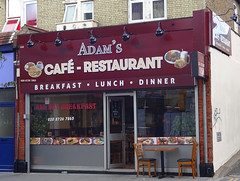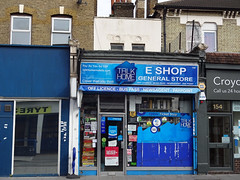154 London Road is currently occupied by Croydon Funeralcare, a funeral home run by the Co-op with a tenure of over 70 years.
1900s: Conversion into a shop
Until the early years of the 20th century, the properties now numbered 152–162 comprised three private houses — one detached, and a semi-detached pair. It was the detached house which corresponded to today’s 152–154 London Road, and I’ve already told the story of its time as a private residence in my article on number 152. Here I describe the history of number 154 after all three houses were converted to shops around 1906.[1]
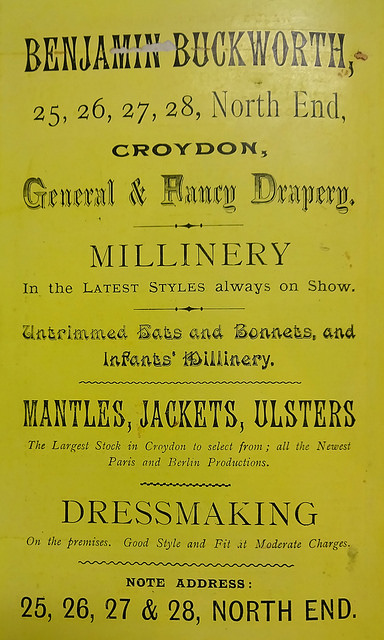
1900s–1910s: John Hood Mulliner, draper and milliner; and Eleanor Merritt, dressmaker
The first occupant of the new shop was John Hood Mulliner, a 30-something draper and milliner who also lived on the premises along with his wife Clara and their young son Archibald. Even though number 154 was itself a subdivision of the old detached house, the Mulliners were not the only people living here; the 1911 census records a dressmaker, 31-year-old Eleanor Merritt, as a separate householder at the same address.[2]
John and Clara may have met each other through their work in the drapery trade. Although born in Bournemouth, by the time she was 21 Clara was working as a draper’s assistant at Benjamin Buckworth’s drapery, millinery, and dressmaking establishment on North End in Croydon. She and John married around five years later, in 1896, but spent some time living in Tulse Hill before moving to London Road.[3]
1910s–1920s: The Curio Shop, gramophones, and a bootmaker
Around 1914, John’s drapers shop was replaced by The Curio Shop, run by one F C Remmett. Although this remained for over half a decade, no further information about it survives. It was most likely some sort of antiques shop.[4]
F C Remmett departed by 1923, and was replaced in quick succession first by J W Shepherd, who dealt in “Gramophones &c”, and then by a bootmaker named J Hoare. Neither remained long, and both were gone by 1925.[5]
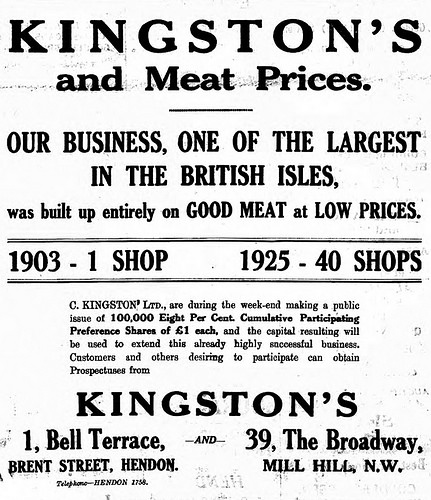
1920s–1930s: C Kingston Ltd, butchers
Next to arrive was a branch of C Kingston Ltd, a chain of butchers. Founded by Charles Kingston in 1903 as a single shop, by the time it became a limited company in 1925 the chain had grown to around 40 branches in and around London. Although swiftly swallowed up by the Union Cold Storage Company (a subsidiary of what later became the Vestey Group), the shops continued to operate under the C Kingston name, like other previously-independent retail butchers in the group such as J H Dewhurst and R C Hammett.[6]
The London Road branch opened in 1924, along with eleven other branches of this rapidly-expanding chain. It remained here until the early 1930s.[7]
1930s: Arthur E Cook Ltd, electrical contractors
By 1934, C Kingston Ltd had been replaced by Arthur E Cook Ltd, a firm of electrical contractors established around 1920 on Greenside Road (a side road running west off London Road just a little further north). The firm remained on London Road until the end of the decade before moving first to Station Road and later to St Michael’s Road.[8]
1940s–present: Co-operative Funerals
Arthur E Cook’s replacement would turn out to be an enduring one. The South Suburban Co-operative Society (SSCS), which had its main headquarters just down the road at number 99–101, resolved in the early 1940s to begin offering funeral services for its members.
In doing this, it was following the example of other co-operative societies, such as the Royal Arsenal Co-operative Society (RACS), which had introduced funeral furnishing in 1929. Indeed, according to Gillian Lonergan at the National Co-operative Archive, “co-operative societies were involved in funerals at the end of the nineteenth century, though funerals at that time were normally carried out by the family and the major need was for a coffin and a means of transporting it to the cemetery. Societies’ works departments often organised the making of a coffin and loan of a wagon.”[9]
The SSCS was thus relatively late in beginning to provide funeral services. It isn’t clear what prompted it to finally get around to this, though requests from members may have been part of the reason; one example comes from a series of “Food Conferences” held by the SCCS in October and November 1941, attended by both officers and members of the Society. A brief report on these conferences notes that “It was evident that on the whole the members were fairly satisfied with the service given by the Society, and felt they had no real cause for complaint after two years of war” but that “Requests were made for greengrocery, fishmongery, laundry and funeral furnishing services”.[10]
The SSCS Committee considered two main options for funeral provision, both in conjunction with other societies: the Co-operative Wholesale Society (CWS) and the RACS.
The CWS Funeral & Monumental Department had been set up just a handful of years earlier, in 1937, both to support societies that were carrying out funerals themselves and to provide a full service where societies did not offer funeral provision. On 4 October 1941, two officers of the CWS “placed before the Committee full particulars of their Funeral Service with other Societies, and stated they would be prepared to enter into the same arrangement with this Society. The CWS would provide all Buildings, Plant and Staff to operate the scheme in its entirety and allow a Discount of 15% in the total Service Charges to Members (no discount being allowed for fees &c).”[12]
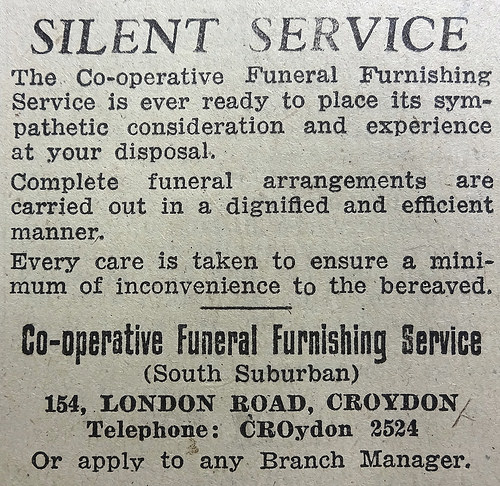
By early 1942, the SSCS also had an offer from the RACS to provide “full service to our members in the vicinity of their depots and allow a commission of 10% on the business”. However, “With regard to the major question of development of the business after the War, and erecting necessary buildings, and providing all equipment and staff &c, they could give no definite understanding.” and so “After full consideration it was resolved to renew the discussions with the CWS.”[13]
On 23 April 1942, the Committee resolved “that the agreement with the CWS now be signed”, and the new “Co-operative Funeral Furnishing Service (South Suburban)” was open at 154 London Road by late 1944.[14]
The link between the SSCS and the CWS became even stronger in the 1980s, as the two Societies agreed to merge with effect from July 1984; the RACS joined the merger less than a year later. Another merger, in 2000, between the CWS and the Co-operative Retail Services (CRS), led to the creation of the modern Co-operative Group.[15]
Today, Croydon Funeralcare is essentially a one-person operation, run by manager Jan Hicks. The public space consists of two small chapels of rest on the current ground floor, and an arranging room up a half-flight of steps on what would have been the ground floor of the original private house. Jan’s office space is further back, behind the arranging room, while the upper floors are used for residential purposes and accessed via a separate entrance to the side of the street frontage.
The chapels of rest, which give the bereaved space and time to sit quietly with the coffin, have been given locally-relevant names in line with the Co-op’s usual practice. Here, they’re named “Whitgift” and “Whetheral”. The first of these is obviously after John Whitgift, the Archbishop of Canterbury who gave his name to many other places and organisations in Croydon, but it’s not at all clear what “Whetheral” refers to. Any information on this would be most gratefully received![16]
Thanks to: Gillian Lonergan at the National Co-operative Archive; Jan Hicks at Croydon Funeralcare; everyone with whom I discussed the question of the name “Whetheral”; the Planning Technical Support Team at Croydon Council; the staff, volunteers, and patrons at the Museum of Croydon; and my beta-reader bob. Census data and London phone books consulted via Ancestry.co.uk.
Footnotes and references
- See my article on 152 London Road for details of the conversion.
- John H Mulliner, draper and milliner, is listed at 56a London Road (later renumbered to 154) in Ward’s directories from 1907 to 1913 inclusive. The 1911 census lists two households at number 56a: one (with four rooms) consisting of John, Clara, and Archibald, and the other (with two rooms) consisting solely of Eleanor Merritt, an unmarried 31-year-old dressmaker. John and Clara’s marriage is stated as have lasted 14 years at that point, and Archibald is 5 years old, born in Tulse Hill.
- The 1891 census lists 21-year-old Clara Flemington along with 27 other draper’s assistants, draper’s apprentices, milliners, and milliner’s assistants at 25–27 North End, which according to Ward’s 1892 directory was then occupied by B Buckworth, general draper, milliner, and costumier. Her age and date of birth match Clara Mulliner’s in the 1901 and 1911 censuses, and the England & Wales Civil Registration Marriage Index, 1837–1915, lists Clara Flemington and John Hood Mulliner on the same page as each other (Vol 2a, p558), both in Croydon in the second quarter of 1896. The 1901 census shows John and Clara at Tulse Hill.
- Ward’s directories list the shop as unoccupied in the 1914 edition, and as occupied by F C Remmett, The Curio Shop, from 1915 to 1922 inclusive.
- Ward’s directories list J W Shepherd, Gramophones &c, in 1923; J Hoare, Bootmaker, in 1924; and Charles Kingston, Butcher, from 1925 onwards.
- An advert on the front page of the 1 May 1925 Hendon & Finchley Times (reproduced here) states that C Kingston Ltd had one shop in 1903 and 40 shops in 1925 (viewed online via the British Newspaper Archive; requires subscription). An article on page 5 of the 28 February 1925 The Scotsman gives instead a figure of “41 butchers’ shops in and around London”, and states that “Twelve new shops were opened in 1924, and are already well established” (also viewed online via the British Newspaper archive). An stock exchange prospectus published on page 10 of the 21 November 1927 Western Daily Press states that “the whole of the Share Capital of [...the companies listed underneath...] is owned by the Union Cold Storage Company, Limited”; these companies include “J. H. Dewhurst, Limited”, “C. Kingston, Limited”, and “R. C. Hammett, Limited” (viewed online at the British Newspaper Archive; requires subscription). It’s perhaps worth noting that R C Hammett had a branch at 30 London Road around the same time that C Kingston was at number 154, and J H Dewhurst later opened at number 51–53. For more information on the Union Cold Storage Co and the Vestey Group, see “Meat The House Of Vestey” on the Let’s Look Again website.
- Ward’s directories list Charles Kingston, Butcher, at 56a London Road (later renumbered to 154) from 1925 to 1932 inclusive (note that the information for these directories was generally finalised late the previous year). Kelly’s 1927 directory lists C Kingston Ltd, butchers, along with one Ernest G Cole, who may have been a resident manager or who may have simply lived above the shop and had nothing to do with it. The number of branches opened in 1924 is taken from The Scotsman article referenced in the previous footnote.
- Ward’s directories list Arthur E Cook, electrician, at 7 Greenside Road from 1921 to 1928 inclusive; Arthur E Cook Ltd, electrical contractors, at 17A Station Road from 1929 to 1932 inclusive; and A Cook Ltd, electrical contractors, at 152 London Road in 1934, 1937, and 1939 (the final three editions of these directories). A photocopied advert from the July 1949 Croydon Manufacturing & Industrial Exhibition catalogue (found in the firms files at the Museum of Croydon) lists Arthur E Cook Ltd, 6 St Michael’s Road, as one of Croydon’s National Registered Electrical Installation Engineers and a member of “Croydon Electric Circle”. Two advert clippings, also found in the firms files, state that Arthur E Cook Ltd has been established for 35 years and 37 years respectively; the handwritten dates on these clippings are 1954 and 1959, which doesn’t quite match up, but suggests the firm was founded around 1920. Arthur E Cook does not appear in Ward’s 1919 directory, which fits well with this.
- Date of introduction of RACS funeral services is from Ron Roffey’s The Co-operative Way, page 56. Information from Gillian Lonergan provided via email, 15 March 2017.
- The report consists of two A4 pages and is dated December 1941; it is accompanied by a list of the dates and locations of the 14 conferences. Viewed at the Museum of Croydon; it doesn’t appear to have its own accession reference but is stored inside the August 1940–March 1943 SSCS minute book (number 60 under “Records of Co-Operative Wholesale Society, South Suburban Branch, 1880–1961”).
- See previous footnote for more information on this report.
- Information on the CWS Funeral & Monumental Department provided by Gillian Lonergan at the National Co-operative Archive (via email, 15 March 2017). Quotation taken from the August 1940–March 1943 SSCS minute book (record of meeting on 4 October 1941).
- Quotations taken from the August 1940–March 1943 SSCS minute book (record of meeting on 24 January 1942).
- Quotation re agreement taken from the August 1940–March 1943 SSCS minute book (record of meeting on 23 April 1942). Nothing else relevant appears in the minute books up to and including the end of 1944, aside from a note regarding the meeting on 12 September 1942, when it was “Resolved that a temporary building be erected at Franklin Road, Penge to be used as a Chapel of Rest in connection with the Co-operative Funeral Service”. The first phone book appearance I’ve found of any South Suburban Co-operative Society “Funeral Furnishing” services is at 154 London Road in the May 1945 London edition (the May 1943 edition has no such listing, while unfortunately the 1944 edition covering “S” is unavailable). The only other 1945 entry in the “Funeral Furnishing” subsection of the SSCS entries is a “Workshop” on Franklin Road, SE20. The branch was certainly open by late 1944, as there’s an advert for it (under the name “Co-operative Funeral Furnishing Service”) on page 4 of the 3 November 1944 Croydon Advertiser.
- See my article on 99–101 London Road for more information on the SSCS/CWS/RACS merger, and History of Co-operative Group (CWS) Ltd on FundingUniverse for more information on the CWS/CRS merger.
- Information about Croydon Funeralcare today comes from a visit to the premises and a conversation with Jan Hicks (10 March 2017). All my attempts to find out who (or what) Whetheral was have come to nothing. Sean Creighton and Ron Brooker both independently made the useful suggestion that it could have been the name of someone prominent in the SSCS, but I haven’t been able to confirm this. Others have suggested that it could be a misspelling of “Weatherill”, in relation to Bernard Weatherill, MP for Croydon North East between 1964 and 1992, but this does seem a rather egregious misspelling, and in any case Ron also points out that Bernard Weatherill “was a moderate Tory whereas the Co-op are Labour supporters, having Labour & Co-operative MPs” (via email, 27 March 2017).
